Menus
- Naked bikes with inline four cylinders
- Only one with a semi-active chassis
- MV was unfortunately not available
- ENGINE
- Smoothest clutch
- Only one homologated to Euro 4
- Lively and drinkable
- LANDING GEAR
- Brilliant handiness with fantastic stability
- Sit down and hit the line
- EVERYDAY LIFE
- Traction control is not an exaggerated luxury
- SECURITY
- Brakes
- COSTS
- Inspection costs
- Conclusion
- Score overall overview
- The showdown has to wait
- Technical specifications
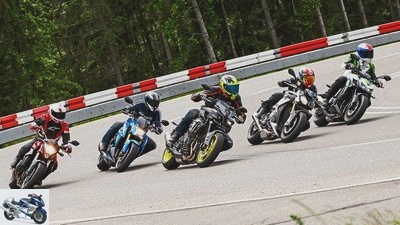
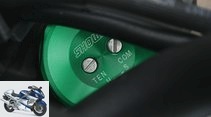
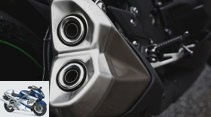
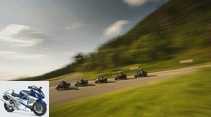
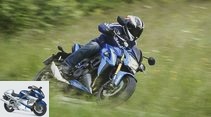
31 photos
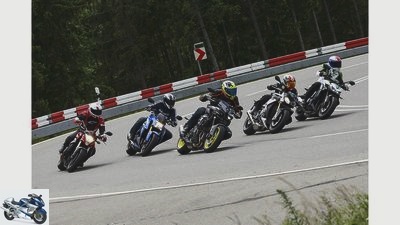
1/31
BMW S 1000 R, Honda CB 1000 R, Kawasaki Z 1000, Suzuki GSX S 1000 and Yamaha MT 10 in the comparison test.
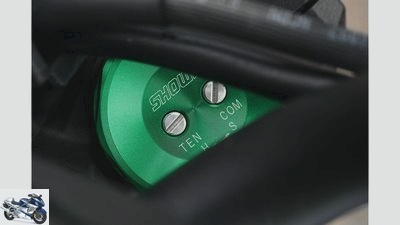
2/31
The setting options of the Big Piston Fork do not change this either.
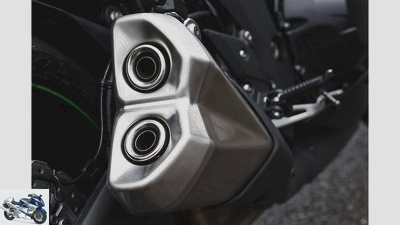
3/31
Kawasaki Z 1000.
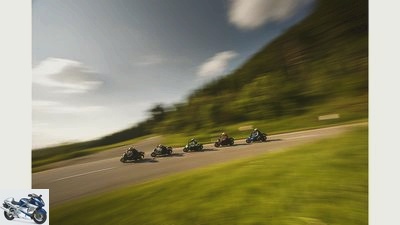
4/31
BMW S 1000 R, Honda CB 1000 R, Kawasaki Z 1000, Suzuki GSX S 1000 and Yamaha MT 10 in the comparison test.
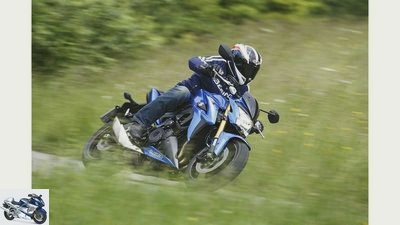
5/31
The economical Suzuki collects points diligently, does not make any major blunders in any discipline and simply offers a lot of motorcycle for the money.
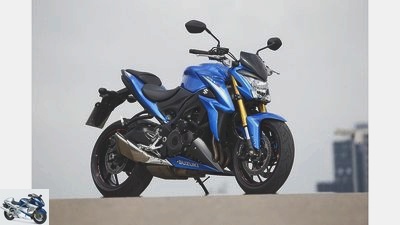
6/31
Suzuki GSX-S 1000: Last year, the Suzuki joined the ranks of naked bikes based on super athletes.
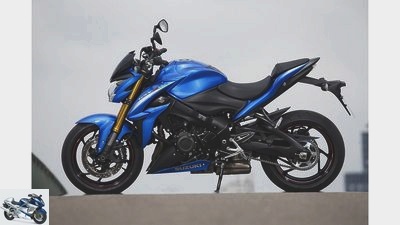
7/31
In it the GSX-R engine of the K5 gets new honors.
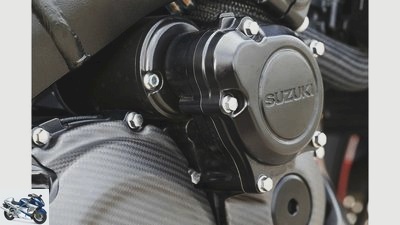
8/31
The protruding housing for the starter drive is striking.
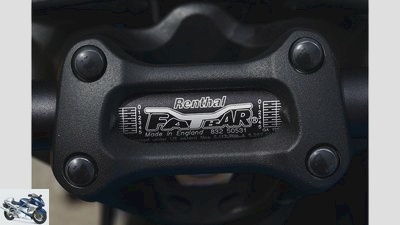
9/31
Even if the pretty Renthal handlebar costs 79.95 euros extra.
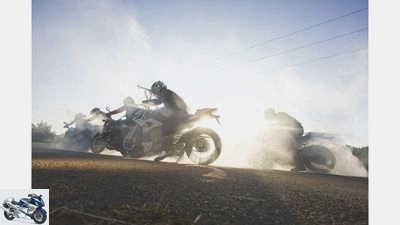
10/31
BMW S 1000 R, Honda CB 1000 R, Kawasaki Z 1000, Suzuki GSX S 1000 and Yamaha MT 10 in the comparison test.
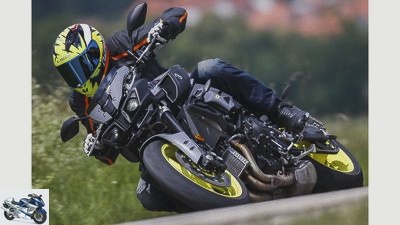
11/31
Woe if the Yamaha four-cylinder drops the hammer…
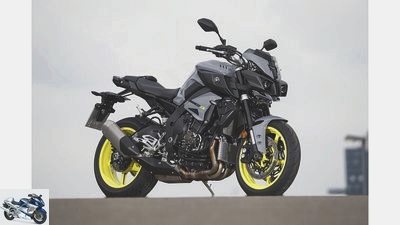
12/31
Yamaha MT-10, the challenger. Boldly styled. Your crossplane engine concept with crank pin offset comes from MotoGP.
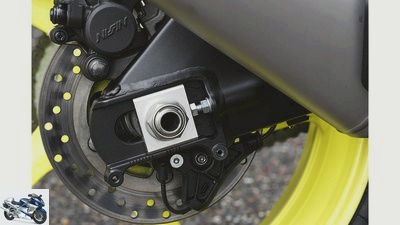
13/31
Due to the two teeth larger chainring than the R1, the rear wheel moves further forward.
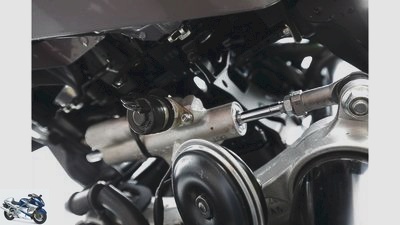
14/31
The steering damper, which works with an electronic valve, is a welcome help on bumpy roads.
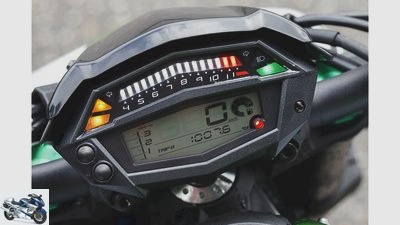
15/31
The split tachometer is difficult to read, too small.
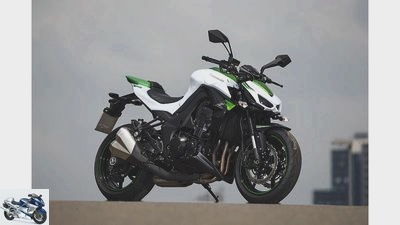
16/31
Kawasaki Z 1000: Evil eye, grim sound. The Z 1000 is not for people who don’t want to attract attention. The eccentric swing arm is also striking.
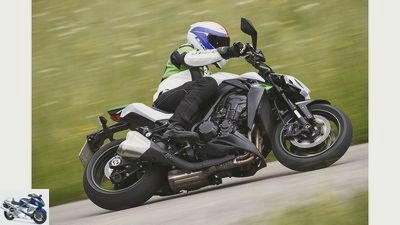
17/31
Looks casual, but requires commitment, because the suspension setup of the Z 1000 is not ideal for the brisk curve dance.
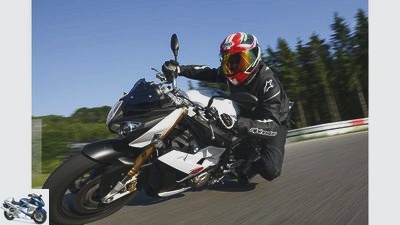
18/31
Weird, weird, BMW. No one bends as boldly as the S 1000 R..
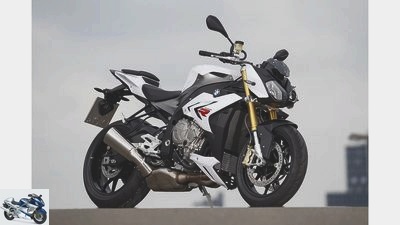
19/31
BMW S 1000 R: With an extensive electronic arsenal and the most powerful engine in the field…
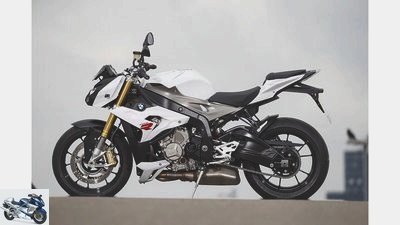
20/31
… the agile BMW is the top dog.
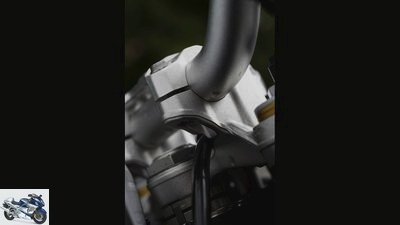
21/31
Far back on the fork bridge is the very flat and wide handlebar, which puts a lot of load on the front wheel.
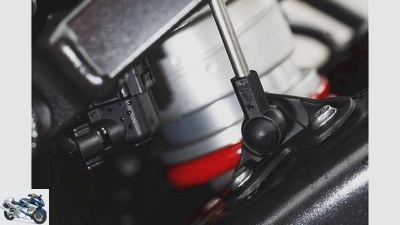
22/31
The spring travel sensor of the semi-active shock absorber provides information on damping adjustment.
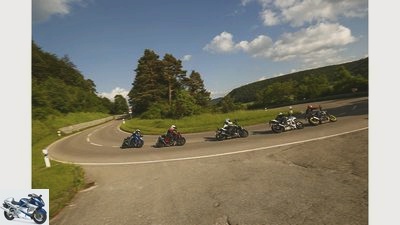
23/31
BMW S 1000 R, Honda CB 1000 R, Kawasaki Z 1000, Suzuki GSX S 1000 and Yamaha MT 10 in the comparison test.
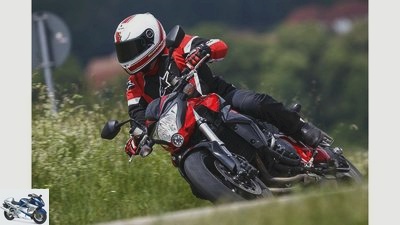
24/31
The CB 1000 R supports the line selection with fine steering behavior.
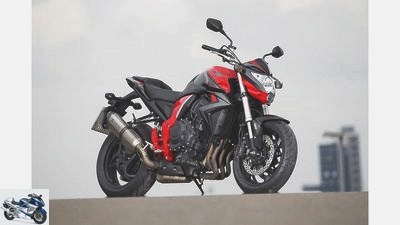
25/31
Honda CB 1000 R: The Honda has been part of the model range since 2008 and has only seen subtle model updates since then. She is the only one who adorns herself with a single-sided swing arm.
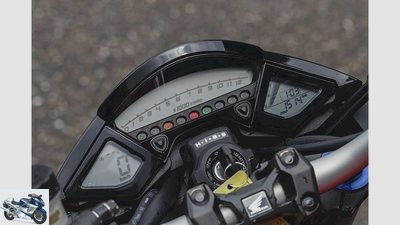
26/31
The low-contrast display of the Honda CB 1000 R is rather difficult to read.
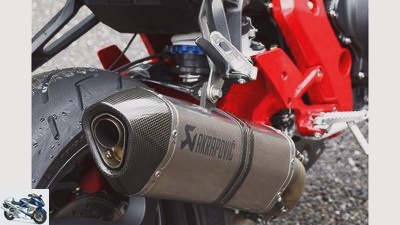
27/31
The Akrapovic exhaust is not standard and costs a good 800 euros extra.
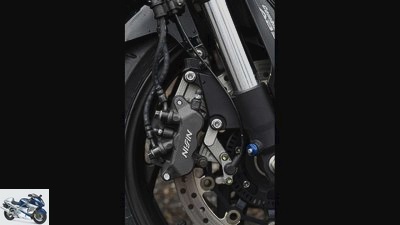
28/31
It is the only one to have three-piston floating calipers on the front, with one piston actuated by the rear brake.
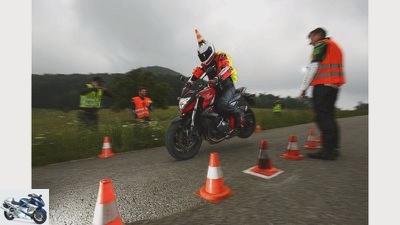
29/31
Strong stoppers are good form.
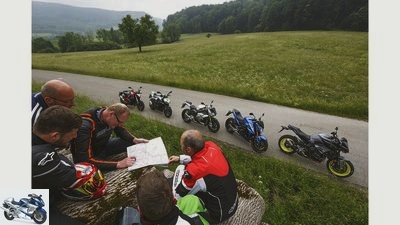
30/31
BMW S 1000 R, Honda CB 1000 R, Kawasaki Z 1000, Suzuki GSX S 1000 and Yamaha MT 10 in the comparison test.
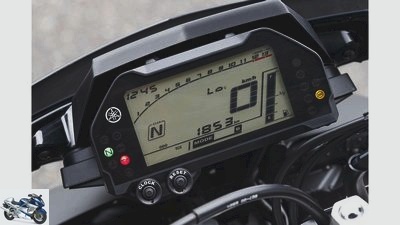
31/31
Yamaha MT-10.
BMW S 1000 R, Suzuki GSX-S 1000, Honda CB 1000 R, Kawasaki Z 1000 and Yamaha MT-10 in the test
Naked bikes with inline four cylinders
In part one of the big power naked bike comparison, V-Twins, Triple and V4 competed against each other. Everything that does not have an inline four-cylinder. They are now allowed to cross the blades in the second part. BMW S 1000 R, Suzuki GSX-S 1000, Honda CB 1000 R and Kawasaki Z 1000 challenge the brand new Yamaha MT-10.
S.you are the real curve robbers on the country road. Powerful naked bikes. Here, crisp chassis, brilliant power and the latest technology merge to create top-quality fun. However, they have still retained a good deal of suitability for everyday use and are therefore by no means as uncompromising as their counterparts with clip-on handlebars, from which they usually inherited engines and mostly also chassis. That goes down well.
Buy complete article
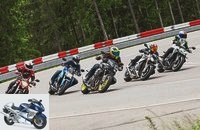
BMW S 1000 R, Suzuki GSX-S 1000, Honda CB 1000 R, Kawasaki Z 1000 and Yamaha MT-10 in the test
Naked bikes with inline four cylinders
Issue 9/2016) was used for everything that does not have an inline four-cylinder. The KTM 1290 Super Duke R emerged as the clear winner from this exchange of blows.
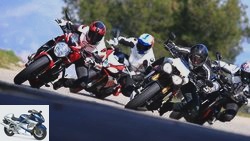
Naked bike
Aprilia Tuono 1100 Factory, Ducati Monster 1200 R, KTM 1290 Super Duke R, Triumph Speed Triple R.
Part 1 of the power naked bike comparison test
read more
Only one with a semi-active chassis
So now ask the in-line four-cylinder to test your strength. And so the story goes back to its roots. After all, machines like the Kawasaki Z 900 were the first powerful nakeds. And it wasn’t long before undisguised big bikes – all of Japanese origin – competed for race victories in the AMA Superbike Championship in America at the beginning of the 80s. Powerful nakeds with sport-compatible chassis have a long tradition in Japan. And so the second part of this test is also firmly in Japanese hands, enriched by the white and blue Imperator BMW S 1000 R..
It has a special position in this field. She is the only one that competes with a semi-active chassis. Which of course is also reflected in the price. At 15,105 euros, the BMW pleasure is not cheap. In addition, the 12,995 euros that are called for the 160 hp Yamaha MT-10 look moderate. The Yamaha is not a budget package, it does not have an electronic chassis in its luggage, but the noble chassis of the superbike YZF-R1 with its high-quality suspension elements. In addition, she is the only one who swims against the current when it comes to firing order. If the other test persons ignite at a regular 180 degree crankshaft rotation distance, the MT-10 has crank pins offset by 90 degrees with the correspondingly irregular ignition intervals. Smoky timbre included.
MV was unfortunately not available
In a way, the Honda CB 1000 R also stands out from the test field. She is the only one to have the rear wheel in a single-sided swing arm, and with 10,505 euros it even goes through as a bargain in this round. Occasionally even for 9990 euros in the shop windows. And with 125 HP it eludes turning the power spiral. But you shouldn’t make the mistake of measuring them by their performance alone, because it’s still the overall package that decides.
So far, the Kawasaki Z 1000 has earned the price for the most martial design, which it must now give to the Yamaha MT-10. But she has retained her extremely powerful four-cylinder. With its nominally 142 PS, it is on par with the 146 PS strong Suzuki GSX-S 1000. And in terms of price with 12,195 euros, it is exactly on par with the cent. Before the engines are started, just a word about a participant who is not there: The MV Agusta Brutale is of course also part of this illustrious club, but no test motorcycle was available for this test. So you only have the role of the spectator while the others get into the ring.
ENGINE
Inline four-cylinder is the same as a uniform mixture? Are you kidding me? Are you serious when you say that. It is true that they all descend from super athletes, which guarantees robust performance. But the five still have a pretty independent character.
Who invented it? Exactly, the Japanese. Well, not exactly invented, but at least they made the inline four-cylinder in motorcycles socially acceptable. And drawn to such cultivated maturity and efficiency that it has become synonymous with motorcycles from Japan. With the CB 1000 R, Honda is sending the weakest engine, at least on paper, into the race. It is basically based on the 2007 Fireblade unit, so it is no longer a completely fresh design.
But this is not really a disadvantage, because on the one hand its 125 hp is always enough for sovereign intermediate sprints and overtaking maneuvers. On the other hand, the engine of the Honda CB 1000 R is one of those drives with a high flywheel mass that pulls in cleanly just above idle, with which you can cruise through the city in a relaxed and unobtrusive manner at almost 2000 rpm in sixth gear With a casual twist of the right wrist, the sign at the end of the town disappears in the rearview mirror in no time. Old school: fine response, great concentricity at the lowest speeds, pressure from the cellar. He is not fiery, but fine and soft on the gas, marches evenly and without vulgar roar up the speed ladder. The fact that he has the smoothest load changes of the quintet underlines his serious demeanor. Only the fine vibrations from 4000 rpm do not quite fit into the picture. The Honda quad is still a good choice for fans of relaxed, confident drive who place more value on smooth, predictable power delivery than on pure top performance.
Smoothest clutch
The Kawa drive is much more excited. Sure, as a Kawasaki Z 1000 you have a reputation to lose. And so it sounds as grim from its four end pots as it looks from its projection headlights. When the gas is drawn in, it roars full-bodied from the airbox. But the Kawa has more to offer than just putting on thick pants. Tangible pull-through qualities, for example. It pushes forward powerfully from low locations and shows the Japanese competition where the hammer hangs. Although it weighs the most pounds. The four-cylinder runs well, with noticeable load changes. Whereby these are significantly lower than with some previous test copies. Even the slightly delayed throttle response, as if the throttle valves were stuck in the intake tract the first time the throttle was applied, is not noticeable, apart from a minimal remainder. To do this, the Zett conjures up an exemplary torque curve on paper, which can be savored anew at every curve exit in the form of a full punch. In addition, the Kawasaki Z 1000 pleases with the smoothest clutch and the slipperiest gear changes. Lo and behold, under the supposedly rough shell there is a sociable core.
The drive of the Suzuki GSX-S 1000 behaves in a similar way. And it shows once again that the engine of the GSX-R 1000 K5, which it is basically, is a very splendid country road burner. Longer-stroke than the current sports engines, it already piles up heaps of Newton meters in the first half of the rev range, which gives it a splendid acceleration from below. Always accompanied by a nice snotty four-cylinder sound. But that’s not all, from 7000 rpm the post goes off. He simply cannot deny his origins as a sports engine. Angry he burns up the speed ladder. Measured 157 PS are an announcement. One likes to turn a blind eye to the significant load changes. Especially since the Suzuki hits excellent pulling power and brilliant acceleration values on the asphalt.
Only one homologated to Euro 4
But it can be even more powerful. What the Bavarian engine squeezes out of the cylinders is insane. Not only because of the imposing 168 hp peak performance. When the BMW S 1000 R tears out at the top, the air burns. But what is almost even more impressive is the force with which it marches forward from low speeds, how it manages to combine immense peak performance and pulling power. Power is simply always in abundance. There is no breather. Gas commands convert the bundle of energy directly into propulsion. It seems to be bursting with activity. But can also purr cautiously through the country in large corridors. Provided you have your gas hand under control. With all this, the thirsty four-cylinder is not a fine spirit. Luscious growls at low speeds, rushes into five-digit speeds with a mighty outcry, babbles dirty in push mode. And is always mechanically present. The gear changes are a bit resinous. But the optional automatic switch helps a little over that.
In view of the impressive performance of the four-cylinder BMW S 1000 R, the crucial question is: Can the Yamaha MT-10 restore the honor of Japan and straighten the hierarchy? After all, the crossplane four-cylinder with its crank pin offset is an ultra-modern design. Presses 200 hp in the uncorked version in the superbike YZF-R1. In the futuristically styled naked bike – the only one in the field already homologated to Euro 4 – still real 158 hp and more clearly trimmed for torque and pulling power, the chances are not bad. But at first the Yamaha drive is very good. Its dark, V4-like growl is a feast for the ears. It stands out pleasantly from the four-cylinder howling of the others.
Lively and drinkable
From 2500 rpm it also runs smoothly in the upper gears. From 4000 rpm the Yamaha MT-10 inflates the nostrils for the first time. And from 6000 rpm a second fire rushes through the combustion chambers. At this point at the latest, the MT-10 can no longer be held. Angrily, the engine rushes towards the limiter. And although its torque curve is rather subtle up to 7000 rpm, the MT-10 provides respectable pulling power thanks to its short secondary transmission.
The on-board electronics offer three driving modes, all with full power. “Standard” lets the engine go to work with ease, “B” downright snappy. “A” is a good compromise. The engine hangs wonderfully spontaneously on the gas, twirling effortlessly and with fascinating ease up the speed ladder, as if it only had to accelerate a third of the Honda’s centrifugal mass. The gearbox turned out to be less bony than that copy in the driving report (MOTORRAD 11), but should still act a bit more smoothly. Nevertheless, the Yamaha MT-10 is a lively, but hard-drinking arsonist, who serves his jubilant revving pleasure with throaty roaring. But it’s not quite enough to take BMW’s first chapter victory.
LANDING GEAR
All five have enough power. It just has to be brought to the ground in a manner that is as trustworthy as possible. Which one does it best?
In the engine chapter, the BMW S 1000 R set the clearest scent mark, for the Yamaha MT-10 it was just behind second place. Can she eradicate this notch in the chassis evaluation? In any case, she has good prerequisites for taking a sharp turn around the corner. With a wheelbase of 1400 millimeters, the distance between the two wheel axles is the shortest. The rear axle is in the chain tensioner far ahead, due to the chainring being two teeth larger than the R1. The MT-10 also has the most extreme value for the steering head angle at 66 degrees; its fork is a little steeper than the rest of the field. So that nimble handiness doesn’t turn into nervousness, the Yamaha with 102 millimeters of lag also has the most stability-oriented value of the quintet. That is having an effect. The naked woman from Hamamatsu bends lightly around every bend, nimble as a tuna fleeing from a great white shark. When turning in and accelerating out of corners, it pampers you with confidence-enhancing stability, which it maintains even when running quickly straight ahead.
In addition, its fully adjustable fork is very responsive and has the right answer for every requirement on the road surface. The same applies to the shock absorber, which can also be adjusted in all desirable parameters, and which only rolls a little less sensitively over hard edges. The fork and damper do not buy the good values in terms of stability through unconditional hardness, but let the rider and his intervertebral discs live, offering a level of comfort that is usual for this class. Anyone who also lets it fly properly through the curve with the Yamaha MT-10 can look forward to the lean angle. The substance of the fear nipples on the pegs can hardly be endangered in normal country road operations by machining.
Brilliant handiness with fantastic stability
So far so good. But as with the engine, the better is the enemy of the good. And that is now pushed back into the memory in the form of the BMW S 1000 R. Due to the very wide, low-lying handlebars, the BMW zigzags around bends a touch more nimbly and lies on the road as if they were carpeted. Regardless of whether it is gently rolling through or briskly dashing through, the S 1000 R is never shaken in terms of stability. One of the reasons for this is the semi-active chassis of the BMW. This detects the speed and force of the impulses that have just been introduced into the chassis via spring deflection sensors and adjusts the damping to this in milliseconds. The fact that it tends to be a little unwieldy on paper compared to the Yamaha MT-10 with a 1439 millimeter wheelbase, a steering head angle of 65.4 degrees and a caster of 99 millimeters cannot be experienced in reality. The bottom line is that the BMW S 1000 R unites brilliant handiness with fantastic stability.
If you are still looking for a fly in the ointment, you will find it in comfort. When driven over bumpy slopes, the shock absorber in particular should act more sensitively. So it’s only enough at Yamaha level. What still stands out at BMW, on the other hand, is the feedback. Your pilot knows exactly what is going on under the tires and can change or correct lines according to his own taste, even in curves. As if the BMW were loudly announcing: “Just do it, I’ll take care of it.” That gives you a lot of confidence in your own capabilities and the capabilities of the motorcycle, and makes you fast in a casual way. Only a passenger in the back seat does not take the BMW chassis as easily as the Yamaha counterpart. Even if nobody on the Yamaha MT-10 – like on everyone else – wants to take a seat for longer trips due to the very compact seating arrangement, it would not matter for the fork and shock absorber. The new nude from Japan does not lose any of her lightness when fully loaded.
Sit down and hit the line
The other motorcycles in the test field are a long way off from such a performance in terms of chassis. You find the interplay of feather-light turning and stable driving behavior more difficult. Like the Suzuki GSX-S 1000. The conservative chassis data (1460 millimeters wheelbase, 65 degrees steering head angle and 100 millimeters caster) already indicate the direction, and it goes by the name of stability. The other side of the coin? In terms of handiness, it is only at the back. The fact that your shock absorber works unsteadily in the event of distortions doesn’t make things any better. It certainly has the potential for the agile curve twist. A tire change from the stubborn Dunlop D 214 (in special specification, like on the Kawasaki Z 1000) would help a lot. This is shown by the somewhat grayed Honda CB 1000 R. It rolls through the country on Bridgestone’s S 20 so refreshingly that its age is immediately forgotten. Although it cannot set the best values in the chassis rating either, it throws the almost Honda-typical balance into the balance. Sit on it and hit the line exactly where you look. And with a little more lean angle, it would be directly on the level of the much fresher Suzuki.
The Z 1000 from Kawasaki has to be at the very back. Above all, the mounted tires and the much too hard tuning of the damping front and rear hail a significant increase in points on the account. Even if the screws for rebound and compression on the fork and shock absorber are turned far in the soft direction, almost every asphalt furrow comes through to the driver unfiltered. This has a direct effect on the stability, worsens the steering behavior and offers little comfort. The bottom line is that there is a lack of trust, because the Kawasaki Z 1000 could definitely if it could. Other tires, like the Suzuki GSX-S 1000, would be the right start.
EVERYDAY LIFE
Yes, even fun buffs have to prove themselves when transporting a pillion passenger, at night and on the daily commute to work. Which of the five collects the most diligent points here?
Everyday life? That’s the story that is usually given attributes such as boring or gray. But a few nice splashes of color can also be brought into the dreary gray. For example, with a seating position that fits like a tailor-made suit. Like the Yamaha MT-10. Nothing bothered, the pegs and handlebars are perfectly arranged. This means that drivers of various stature can find their way around straight away. Even our two-meter man Jens grins ecstatically. The Honda CB 1000 R also flatters itself in this regard, maybe folds the knees a little more, but adds the tank nice and narrow between the knees. In general, the Japanese all go in roughly the same direction when it comes to the seating position. Only the BMW S 1000 R leaves it. With the wide, deep handlebar positioned a little further away from the driver, your seating position appears noticeably more trimmed to attack.
And where we’re sitting: A potential passenger is most likely to find acceptable seats on the Honda CB 1000 R, Suzuki GSX-S 1000 and Kawasaki Z 1000. That of the Yamaha MT-10 can go through as a reason for divorce. Tight cushions, the knees of the passenger under the armpits of the pilot, that goes well to the ice cream parlor or the cinema. Certainly not on a longer tour. In this respect, the measly 167 kilograms payload of the MT-10 are also bearable. That is easily enough for one person plus luggage. After all, Yamaha offers panniers. Purely in terms of payload, the BMW S 1000 R would best handle luggage and additional passengers. After all, it can saddle up a whopping 33 kilograms more than the Yamaha. But when it rains, the pillion rider sits even more in the splash of water from the rear wheel than with the others who are just as moderately protective. In general, the tapering rear ends with tight fenders and minimalist rear light holders are only of limited use for larger transport tasks. Especially since proper luggage hooks are only available in rudimentary form.
In everyday life, on the other hand, displays that are difficult to read, such as the Honda CB 1000 R with its low-contrast displays divided into three segments, are more important. The Kawasaki Z 1000 is not covered in fame either, dividing the tachometer in the small cockpit into an LCD part (up to 3000 rpm) and a strip of lights. In addition, both are stingy with information. Gear display, outside temperature or remaining range – no indication.
Traction control is not an exaggerated luxury
After all, the mirrors of the Kawasaki Z 1000 allow the best view back, while the mirrors of the Honda CB 1000 R and BMW S 1000 R are half filled with upper arms. But with the darkness, the kawa pilot’s gaze darkens again. If the headlights are still properly illuminating the road ahead, it will be swallowed up by the darkness in the next bend at the latest. You can certainly do without different engine mappings. But traction control is not an exaggerated luxury these days. Honda and Kawasaki don’t have either on board. After all, the CB 1000 R shines with a composite ABS.
The expensive BMW S 1000 R is lavishly equipped thanks to optional accessory packages. Electronic chassis, ABS that can be switched off, multi-level traction control, automatic gearshift, heated grips, cruise control, everything on board. The Yamaha MT-10 also has a few delicacies to offer: fully adjustable chassis, on-board socket and cruise control ex works. And in addition a decent workmanship, to which only the partly cheap-looking plastic parts like the scratch-sensitive cockpit don’t fit. It gets annoying at the gas pump. Because if you want to put the last one and a half liters into the fuel tank of the Yamaha, you need a lot of patience. Only then to find out that the MT-10 is practicing proper drinking habits. With tame gas hand, she drained the 17-liter tank after just 250 kilometers. What you bring in the red lantern together with the low payload in this chapter.
SECURITY
Strong stoppers are part of good sound, ABS anyway. But despite a fairly similar basis, there are clear differences between the five – here are the details.
If we roll up the field from behind, take a clarifying look at the points table. The BMW S 1000 R is ahead, its lead is clear. A good part of it goes to the evaluation of the assistance systems. ABS, traction control, driving modes: everything is available and everything is adjustable. In addition, there is an automatic gearshift for changing gears under load when accelerating. This makes the counter cushion grow because the others are more cautious. Only the Yamaha MT-10 holds against it with different driving modes and several preselection options for the traction control. So there is a net and a double floor for safety to this extent only from BMW. That has to be rewarded, also because the assistance systems work well apart from the somewhat clumsy automatic switchgear.
If you briefly ignore the aspect of assistance systems, however, you immediately notice how close all five motorcycles are to one another. And that’s a good sign. Or just to break it down to the brake aspect: The naked cannons can not only accelerate with pleasure and force, but can also anchor really well if necessary.
Brakes
In the details, however, there are visible and tangible differences. All motorcycles are adorned with radial hand pumps on the right end of the handlebar – except for the Yamaha MT-10. In contrast to the R1, it is equipped with a conventional brake pump. Can you feel this difference? Yes, of course. Especially in cold and damp conditions, the Yamaha lacks real crispness when laying the pads. Otherwise, its pressure point is not as stable and finely palpable. There would be more. However: The performance of the Yamaha MT-10 when braking always remains the same. Whether alone or as a couple, fading is a foreign concept for the MT-10. She’ll come to a standstill for sure. And when it really has to be, your ABS ensures a reliable stop, even if the control intervals are somewhat rough.
The BMW S 1000 R is noticeably different when it comes to braking performance. Anyone who carelessly pulls the lever to the right of her will almost lose his eyes. It’s crazy how it works. Once used to it, one finger is enough to slow the naked woman with the propeller on the tank at the right speed before the curve. The dosage is sensitive and linear, seasoned with a brutal effect. It gets a little hairier with passengers because the BMW tends to stop in the Dynamic or Dynamic Pro modes (subject to a surcharge).
The Kawasaki Z 1000 is only slightly inferior to the braking performance of the BMW S 1000 R. It cannot be decelerated quite as hyper-precisely as the BMW, because the brake bites the discs a little more abruptly. In addition, the effect is a touch worse. But the bottom line is that these two systems are beyond any doubt.
With slight drawbacks, that also applies to the rest of the field and the ABS function of all motorcycles. Honda CB 1000 R, Kawasaki Z 1000, Suzuki GSX-S 1000 and Yamaha MT-10 do not scare their pilots when they do a research stop for two because they remain manageable and stable and do not allow extreme driving situations like the BMW. The Honda stop for the chapter picture was specially provoked.
It only gets trickier for the Kawasaki Z 1000 when it comes to handlebar slap. The hard chassis makes the handlebars light over bumps. A steering damper wouldn’t be bad. The BMW S 1000 R and the Yamaha have it, with the MT-10 electronically controlled. Honda CB 1000 R and Suzuki GSX-S 1000 dispense with the kickback preventer, and are less critical than the Kawasaki in terms of handlebar slap.
COSTS
“Got a euro?” No, the five powerful four-cylinder units are not suitable as pure economy vehicles. Hence the question of how expensive the fun will be in detail.
Cost, the word sounds joke-free, but the bare five of this comparison were built just for joyful paddling. Scurry quickly over the house route, glide with relish through the sunset: That counts. Everything else seems like unnecessary hair-splitting, spoils the fun too much. That’s true. But let’s be honest: Who hasn’t caught themselves comparing current gasoline prices? If the expensive juice can be found somewhere cheaper, the offer is gratefully accepted. So it doesn’t have to be a sacrilege to look at euros and cents when looking at the jokes. After all, the five four-cylinder engines with prices well above 10,000 euros have already left a considerable hole in the household budget. It would be nice if, for example, going to the gas pump weren’t associated with further adversity.
And by and large, the four-cylinder engines make every effort not to let refueling degenerate into an act of sadness. With a consumption of 4.7 liters, the Suzuki is developing into a fuel-saving champion. The others sort themselves well behind it. The Honda gets by with 5.3 liters, the Kawasaki Z 1000 needs a few tenths more with 5.5 liters, and the BMW S 1000 R treats itself to the strongest sip from the fuel barrel with 5.7 liters over 100 kilometers of country roads. The Yamaha MT-10 is still missing. Its driver briefly calculates the consumption at the pump, swallows briefly and is then amazed. The only four-cylinder already homologated to Euro 4 for this comparison approved itself 6.8 liters over 100 kilometers. That’s a hell of a lot. Even when the Yamaha drives straight ahead on the country road in sixth gear with little use of gas at a constant 100 km / h, the current consumption display in the cockpit always reports values of around six liters. Economical looks different, the BMW S 1000 R, Honda CB 1000 R, Kawasaki Z 1000 and Suzuki GSX-S 1000 can do that much better. Even the motor dispenser R1 gets by with a good six liters on the curvy MOTORRAD consumption lap. Although the MT-10 has a shorter gear ratio compared to the super sports car, and accordingly turns a little higher at the same speed, the difference between the consumption remains a blatant.
Inspection costs
Change of subject: inspection costs. The Suzuki shows how it’s done. Long maintenance intervals of 12,000 kilometers and low hourly rates result in the best value. Only the BMW S 1000 R remains within reach. She wants to be checked every 10,000 kilometers, just like the Yamaha MT-10, where the hourly limits are higher. On the other hand, the Honda CB 1000 R and the Kawasaki Z 1000 are already scheduled to visit the next contract partner after 6000 kilometers – if the hours are not too high. The Honda can book a small success for itself with the maintenance costs, because it only needs a 180 tire rear. The rest of the group takes wide and therefore more expensive 190s for a walk. In terms of the guarantee, they are all almost on the same level. BMW S 1000 R and Suzuki GSX-S 1000 get a few more points, that’s it. Fun and savings, that’s okay, especially when the Suzuki is in your own garage. The others are not out of the ordinary either, and don’t let the pleasure of the four-cylinder become annoying. The exception is the Yamaha MT-10. The gas station attendant is happy every time the hoarse rattle of the crossplane quad appears nearby. Not a good sign.
Conclusion
The wild pack – especially the new Yamaha MT-10 – wanted to knock the BMW S 1000 R from the throne. But she was unimpressed by the onslaught.
Veni, vidi – and not won. The aim of the Yamaha MT-10: to challenge the BMW S 1000 R. It does the job well, impresses with fine ergonomics and a nimble high-revving motor. But the BMW can do almost everything a little better. What the MT-10 ended up hailing in second place are the poor payload and the high consumption. So it is only enough for third place behind the Suzuki. The GSX-S 1000 is the recommendation for all cost-conscious naked bike fans. No one offers more fun per cent. The Honda CB 1000 R also keeps up really well. Sure, your engine is the weakest, and the inspection costs should be lower. But the Honda has secretly developed into everybody’s darling. She is committed to low prices and pure wellbeing. This is the problem with the Kawasaki Z 1000. Its engine is powerful, the brakes are hard – but every meter requires more concentration than the others. The Streetfighter ex works wants to be defeated, doesn’t make it easy for you. And then there is the BMW S 1000 R. It can do everything, walks tame through places and turns into a wild animal with a slight turn to the right. Dr. Jekyll and Mr. Hyde in a motorcycle with almost no weaknesses – the test winner of part two.
Score overall overview
Max points
Winner price-performance: Suzuki GSX-S 1000
A lot of power for a small course, the GSX-S 1000 – Chapeau.
The showdown has to wait
In the in-line four-cylinder segment, the BMW S 1000 R is ahead, part one of the comparison between 2-, 3- and V4-cylinder engines was won by the KTM 1290 Super Duke R..
In the end, there were 707 points on the credit account of the KTM 1290 Super Duke R (MOTORRAD 9/2016) in the first test of the power-naked bikes, 731 points for the BMW S 1000 R. The conclusion is obvious: The S 1000 R. is the spearhead under the naked cannons. But be careful: with the 1290 Super Duke GT, KTM has proven that they still have a few arrows in their quiver. The key words are: Euro 4 homologation, semi-active chassis, even more agile handling. Like almost all bare grenades, the BMW must also start rolling in 2017, at least in accordance with the Euro 4 emissions standard. We are therefore eagerly awaiting the next update. The cards will be reshuffled for the 2017 showdown.
Technical specifications
Here you can see an extract of the technical data. If you would like the complete measurement values determined by us, including all consumption, torque and acceleration values, you can buy the article as a PDF for download.
Related articles
-
Comparison test of 125cc naked bikes – Aprilia Tuono 125, Yamaha MT-125 and KTM 125 Duke
18 pictures 1/18 Away with the smartphone, boys and girls. Forget Twit-Snap and Insta-Chat, because real life takes place outside …
-
Middle class naked bikes in comparison test
r-photography.info 30 pictures r-photography.info 1/30 With the Z 900 Kawasaki pushes the middle class close to the full liter. Looks up …
-
Comparison test of naked bikes from Japan
Art 15 pictures Art 1/15 Art 2/15 Art 3/15 Art 4/15 Art 5/15 Art 6/15 Art 7/15 Art 8/15 Art 9/15 Art 10/15 …
-
Comparison test of mid-range naked bikes over 100 hp
31 pictures 1/31 Yamaha MT-09 SP, Kawasaki Z 900, Triumph Street Triple R, KTM 790 Duke, Ducati Monster 821 and Suzuki GSX-S 750 …
-
Nine power naked bikes in a comparison test
fact 57 pictures fact 1/57 Simple, good: excellent readable instrument cluster with analog tachometer and the most important digital. fact 2/57 The …
-
Comparison test of naked bikes with ABS
fact comparison test of naked bikes with ABS Veni, vidi, vici! In comparative tests and approval numbers, the all-rounders Honda CBF 600, Kawasaki ER-6n …
-
Power naked bikes (2019) in comparison test
Topic special Everything about BMW Motorrad fact 29 pictures fact 1/29 In the comparison test, the BMW S 1000 R, KTM 1290 Super Duke R, Yamaha MT-10 SP and …
-
5 power naked bikes comparison test 2018
fact 27 pictures fact 1/27 Ducati Monster 1200, Honda CB 1000 R +, Kawasaki Z 1000 R Edition, Suzuki GSX-S 1000 and Triumph Speed Triple S in …
-
fact 44 pictures fact 1/44 Aprilia Tuono V4 1100 Factory, BMW S 1000 R, Ducati Monster 1200 R, Honda CB 1000 R, KTM 1290 Super Duke R, Triumph Speed Triple …
-
Concept comparison of power bikes from BMW, KTM, Suzuki and Kawasaki
fact 46 photos fact 1/46 At first glance, a fight between a hot naked, a super athlete, a big enduro and an aging launcher may seem rather out of place….